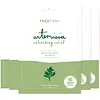What's inside
What's inside
 Key Ingredients
Key Ingredients

 Benefits
Benefits

 Concerns
Concerns

 Ingredients Side-by-side
Ingredients Side-by-side

Water
Skin ConditioningArtemisia Vulgaris Extract
Skin ConditioningButylene Glycol
HumectantGlycerin
HumectantDipropylene Glycol
Humectant1,2-Hexanediol
Skin ConditioningHydroxyacetophenone
AntioxidantCentella Asiatica Extract
CleansingSalix Alba Bark Extract
AstringentAmmonium Acryloyldimethyltaurate/Vp Copolymer
Hydroxyethylcellulose
Emulsion StabilisingBetaine
HumectantAllantoin
Skin ConditioningPolyglyceryl-10 Laurate
Skin ConditioningHamamelis Virginiana Leaf Water
AstringentDipotassium Glycyrrhizate
HumectantTetrasodium Iminodisuccinate
Sodium Hyaluronate
HumectantTocopheryl Acetate
AntioxidantEthylhexylglycerin
Skin ConditioningArtemisia Vulgaris Oil
PerfumingWater, Artemisia Vulgaris Extract, Butylene Glycol, Glycerin, Dipropylene Glycol, 1,2-Hexanediol, Hydroxyacetophenone, Centella Asiatica Extract, Salix Alba Bark Extract, Ammonium Acryloyldimethyltaurate/Vp Copolymer, Hydroxyethylcellulose, Betaine, Allantoin, Polyglyceryl-10 Laurate, Hamamelis Virginiana Leaf Water, Dipotassium Glycyrrhizate, Tetrasodium Iminodisuccinate, Sodium Hyaluronate, Tocopheryl Acetate, Ethylhexylglycerin, Artemisia Vulgaris Oil
Water
Skin ConditioningGlycerin
Humectant1,2-Hexanediol
Skin ConditioningMethylpropanediol
SolventPropanediol
SolventHydroxyacetophenone
AntioxidantMelaleuca Alternifolia Leaf Extract
PerfumingButylene Glycol
HumectantPanthenol
Skin ConditioningAllantoin
Skin ConditioningBetaine
HumectantTrehalose
HumectantMelaleuca Alternifolia Leaf Water
AntimicrobialLactobacillus Ferment
Skin ConditioningAdenosine
Skin ConditioningDisodium EDTA
Carbomer
Emulsion StabilisingMelaleuca Alternifolia Leaf Oil
AntioxidantArginine
MaskingOctyldodeceth-16
EmulsifyingXanthan Gum
EmulsifyingGlycine
BufferingGlutamic Acid
HumectantAspartic Acid
Masking4-Terpineol
MaskingSodium Polyacrylate
AbsorbentSodium Chloride
MaskingSerine
MaskingHistidine
HumectantAlanine
MaskingThreonine
Proline
Skin ConditioningAcrylates/C10-30 Alkyl Acrylate Crosspolymer
Emulsion StabilisingMagnesium Chloride
Calcium Chloride
AstringentWater, Glycerin, 1,2-Hexanediol, Methylpropanediol, Propanediol, Hydroxyacetophenone, Melaleuca Alternifolia Leaf Extract, Butylene Glycol, Panthenol, Allantoin, Betaine, Trehalose, Melaleuca Alternifolia Leaf Water, Lactobacillus Ferment, Adenosine, Disodium EDTA, Carbomer, Melaleuca Alternifolia Leaf Oil, Arginine, Octyldodeceth-16, Xanthan Gum, Glycine, Glutamic Acid, Aspartic Acid, 4-Terpineol, Sodium Polyacrylate, Sodium Chloride, Serine, Histidine, Alanine, Threonine, Proline, Acrylates/C10-30 Alkyl Acrylate Crosspolymer, Magnesium Chloride, Calcium Chloride
 Reviews
Reviews

Ingredients Explained
These ingredients are found in both products.
Ingredients higher up in an ingredient list are typically present in a larger amount.
1,2-Hexanediol is a synthetic liquid and another multi-functional powerhouse.
It is a:
- Humectant, drawing moisture into the skin
- Emollient, helping to soften skin
- Solvent, dispersing and stabilizing formulas
- Preservative booster, enhancing the antimicrobial activity of other preservatives
Allantoin is a soothing ingredient known for its protective and moisturizingg properties. Because of this, it is often added to products with strong active ingredients.
Studies show higher concentrations of this ingredient can promote wound healing.
Though it can be derived from the comfrey plant, allantoin is produced synthetically for cosmetic products to ensure purity.
Learn more about AllantoinBetaine is a common humectant (a substance that promotes retention of moisture). It's known to be gentle on the skin and can help balance hydration.
This ingredient is best for improving hydration and soothing irritated skin. Studies also show it helps even out skin tone.
Fun fact: Betaine is naturally created in the skin and body. The kind found within cosmetic products can be either plant-derived or synthetic.
Another name for betaine is trimethylglycine.
Learn more about BetaineButylene Glycol (or BG) is used within cosmetic products for a few different reasons:
Overall, Butylene Glycol is a safe and well-rounded ingredient that works well with other ingredients.
Though this ingredient works well with most skin types, some people with sensitive skin may experience a reaction such as allergic rashes, closed comedones, or itchiness.
Learn more about Butylene GlycolGlycerin is already naturally found in your skin. It helps moisturize and protect your skin.
A study from 2016 found glycerin to be more effective as a humectant than AHAs and hyaluronic acid.
As a humectant, it helps the skin stay hydrated by pulling moisture to your skin. The low molecular weight of glycerin allows it to pull moisture into the deeper layers of your skin.
Hydrated skin improves your skin barrier; Your skin barrier helps protect against irritants and bacteria.
Glycerin has also been found to have antimicrobial and antiviral properties. Due to these properties, glycerin is often used in wound and burn treatments.
In cosmetics, glycerin is usually derived from plants such as soybean or palm. However, it can also be sourced from animals, such as tallow or animal fat.
This ingredient is organic, colorless, odorless, and non-toxic.
Glycerin is the name for this ingredient in American English. British English uses Glycerol/Glycerine.
Learn more about GlycerinHydroxyacetophenone is antioxidant with skin conditioning and soothing properties. It also boosts the efficiency of preservatives.
This ingredient is not irritating or sensitizing.
Water. It's the most common cosmetic ingredient of all. You'll usually see it at the top of ingredient lists, meaning that it makes up the largest part of the product.
So why is it so popular? Water most often acts as a solvent - this means that it helps dissolve other ingredients into the formulation.
You'll also recognize water as that liquid we all need to stay alive. If you see this, drink a glass of water. Stay hydrated!
Learn more about Water